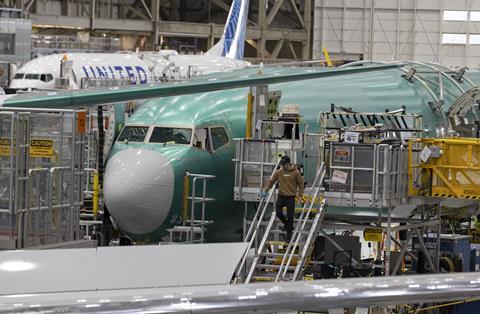A detailed new report alleges that numerous safety gaps still exist within Boeing, including unclear safety-related processes, safety culture disconnects and concerns about the company’s self-oversight system.
The report, compiled in response to a Congressional mandate, also says Boeing’s design work in recent years has given less consideration to “human factors”, such as how pilots interact with cockpit systems.
It attributes that change to Boeing’s decentralised structure, including its decision to move its headquarters far from Seattle.

“The findings and recommendations indicate gaps in Boeing’s safety journey,” says the report, released on 26 February by the Federal Aviation Administration. “The expert panel also found a lack of awareness of safety-related metrics at all levels of the organisation”.
The report comes from a panel of several dozen aviation experts formed by the FAA as required by a 2020 law. That law – a response to two 737 Max crashes – sought to improve the agency’s oversight of Boeing and other aircraft manufacturers.
After the crashes, Boeing took numerous steps it said would improve safety. The company hired a chief aerospace safety officer position, formed safety committees, invested in technology and created a formal safety framework called a “safety management system” (SMS). It also reorganised its reporting structure so all engineers report to a chief engineer, not business-unit heads.
But the report says Boeing has more work to do, making 53 recommendations, most to Boeing, some to the FAA. It asks Boeing within six months to “develop an action plan” to address the recommendations, and asks the FAA to review and “reinforce” the recommendations.
Boeing says it “transparently supported the panel’s review”.
“We will carefully review the panel’s assessment and learn from their findings, as we continue our comprehensive efforts to improve our safety and quality programmes,” the company adds. “We’ve taken important steps to foster a safety culture that empowers and encourages all employees to share their voice.”
The company has faced renewed attention in recent weeks after a door plug blew out of an Alaska Airlines 737 Max 9 during a flight. Boeing has taken responsibility.
The FAA says it “will immediately begin a thorough review of the report and determine next steps regarding the recommendations as appropriate. We will continue to hold Boeing to the highest standard of safety”.
The report says Boeing’s SMS is “not structured in a way that ensures all employees understand their role… Procedures and training are complex and in a constant state of change, creating employee confusion”.
It cites “disconnect between Boeing’s senior management and other members of the organisation on safety culture,” adding that some Boeing workers question the safety reporting system’s effectiveness.
The report also addresses FAA’s Organization Designation Authorization (ODA) programme, through which the agency authorizes Boeing and other aerospace manufacturers to self-regulate compliance with aspects of certification. Under the ODA programme, the FAA approved the flight control system that led both of the crashed 737 Max to enter dives from which the pilots could not recover.
The report says changes made by Boeing have reduced opportunities for company leaders to place undue influence on Boeing staff within the ODA units but that the structure “still allows opportunities for retaliation to occur”.
It also says Boeing’s design work should better account for human factors, citing “lack of pilot input in aircraft design and operation”.
Aerospace companies consider human factors when designing, for example, aircraft cockpits. The designs are intended to ensure pilots interact with cockpit systems in ways that maximise safety.
Boeing had set the human-factors “gold standard” years ago when developing the 757 and 767. But since then, its human-factors considerations “eroded due to… reorganisation, decentralisation, downsizing and relocating the company’s headquarters”, according to the report.
Boeing moved its headquarters from Seattle, where it historically made all its aircraft, to Chicago in 2001, then to Virginia, near Washington, DC, in 2022.
The 737 Max’s cockpit design has been criticised for lacking technological updates that are intended to help pilots understand and address problems.


























